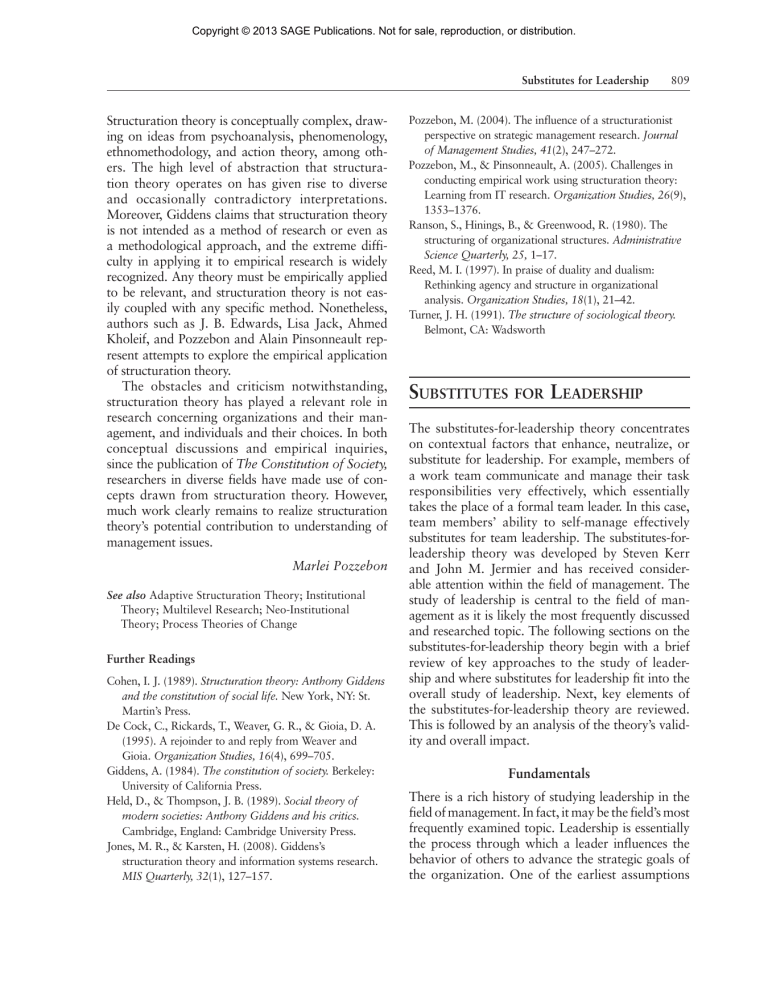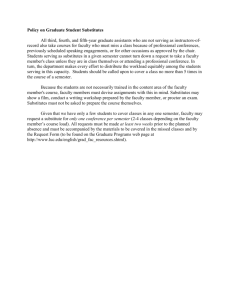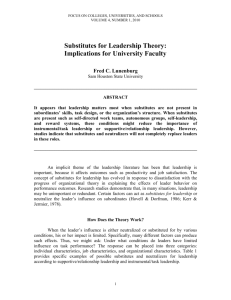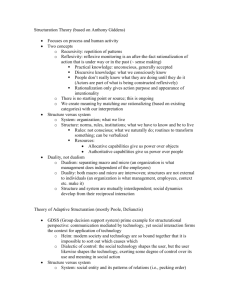4. Substitutes for Leadership - C

Copyright © 2013 SAGE Publications. Not for sale, reproduction, or distribution.
Substitutes for Leadership 809
Structuration theory is conceptually complex, drawing on ideas from psychoanalysis, phenomenology, ethnomethodology, and action theory, among others. The high level of abstraction that structuration theory operates on has given rise to diverse and occasionally contradictory interpretations.
Moreover, Giddens claims that structuration theory is not intended as a method of research or even as a methodological approach, and the extreme difficulty in applying it to empirical research is widely recognized. Any theory must be empirically applied to be relevant, and structuration theory is not easily coupled with any specific method. Nonetheless, authors such as J. B. Edwards, Lisa Jack, Ahmed
Kholeif, and Pozzebon and Alain Pinsonneault represent attempts to explore the empirical application of structuration theory.
The obstacles and criticism notwithstanding, structuration theory has played a relevant role in research concerning organizations and their management, and individuals and their choices. In both conceptual discussions and empirical inquiries, since the publication of The Constitution of Society, researchers in diverse fields have made use of concepts drawn from structuration theory. However, much work clearly remains to realize structuration theory’s potential contribution to understanding of management issues.
Marlei Pozzebon
See also Adaptive Structuration Theory; Institutional
Theory; Multilevel Research; Neo-Institutional
Theory; Process Theories of Change
Further Readings
Cohen, I. J. (1989). Structuration theory: Anthony Giddens and the constitution of social life.
New York, NY: St.
Martin’s Press.
De Cock, C., Rickards, T., Weaver, G. R., & Gioia, D. A.
(1995). A rejoinder to and reply from Weaver and
Gioia. Organization Studies, 16 (4), 699–705.
Giddens, A. (1984). The constitution of society.
Berkeley:
University of California Press.
Held, D., & Thompson, J. B. (1989). Social theory of modern societies: Anthony Giddens and his critics.
Cambridge, England: Cambridge University Press.
Jones, M. R., & Karsten, H. (2008). Giddens’s structuration theory and information systems research.
MIS Quarterly, 32 (1), 127–157.
Pozzebon, M. (2004). The influence of a structurationist perspective on strategic management research. Journal of Management Studies, 41 (2), 247–272.
Pozzebon, M., & Pinsonneault, A. (2005). Challenges in conducting empirical work using structuration theory:
Learning from IT research. Organization Studies, 26 (9),
1353–1376.
Ranson, S., Hinings, B., & Greenwood, R. (1980). The structuring of organizational structures. Administrative
Science Quarterly, 25, 1–17.
Reed, M. I. (1997). In praise of duality and dualism:
Rethinking agency and structure in organizational analysis. Organization Studies, 18 (1), 21–42.
Turner, J. H. (1991). The structure of sociological theory.
Belmont, CA: Wadsworth
S
UBSTITUTES FOR
L
EADERSHIP
The substitutes-for-leadership theory concentrates on contextual factors that enhance, neutralize, or substitute for leadership. For example, members of a work team communicate and manage their task responsibilities very effectively, which essentially takes the place of a formal team leader. In this case, team members’ ability to self-manage effectively substitutes for team leadership. The substitutes-forleadership theory was developed by Steven Kerr and John M. Jermier and has received considerable attention within the field of management. The study of leadership is central to the field of management as it is likely the most frequently discussed and researched topic. The following sections on the substitutes-for-leadership theory begin with a brief review of key approaches to the study of leadership and where substitutes for leadership fit into the overall study of leadership. Next, key elements of the substitutes-for-leadership theory are reviewed.
This is followed by an analysis of the theory’s validity and overall impact.
Fundamentals
There is a rich history of studying leadership in the field of management. In fact, it may be the field’s most frequently examined topic. Leadership is essentially the process through which a leader influences the behavior of others to advance the strategic goals of the organization. One of the earliest assumptions
Copyright © 2013 SAGE Publications. Not for sale, reproduction, or distribution.
810 Substitutes for Leadership in the study of leadership was that effective leaders possessed a specific set of traits. Commonly identified traits were intelligence, charisma, assertiveness, and conscientiousness. However, researchers were not able to identify leadership traits that consistently improved organizational performance across multiple contexts. In the late 1940s, researchers begin focusing on the relationship between leadership behaviors and performance. Surprisingly, no robust, consistent relationships were found between particular leader behaviors and organizational performance. Leadership researchers in the 1950s turned away from leader traits and behaviors and considered the situation within which they operated as the most important factor affecting leadership effectiveness. This, in the 1970s, led to a variety of contingency theories of leadership that hypothesized the fit between the situation and a leader’s style/approach matters most. That is, a leader’s approach may be very effective in one situation but not work at all in another context. This new focus led to Steven Kerr and Anne Harlan’s first mention of substitutes for leadership as factors that lessened a leader’s impact on subordinate outcomes. This paper and several others led to Kerr and Jermier’s paper, published in
1978, that introduced the substitutes-for-leadership theory.
Substitutes-for-leadership theory states that multiple situational factors (i.e., subordinate, task, and organizational characteristics) can substitute for, neutralize, or enhance the impact of a leader’s behavior. These factors can reduce or increase a leader’s ability to influence the job attitudes and effectiveness of subordinates and serve as moderators of the relationship between leader behavior and employee outcomes.
Factors and Characteristics
A variety of different variables have been identified as possible substitutes, neutralizers, or enhancers of leader behavior across the three categories of subordinate, task, and organizational characteristics:
(1) the subordinate’s ability, experience, training, or knowledge; professional orientation; need for independence; and indifference toward organizational rewards; (2) intrinsically satisfying tasks; routine, methodologically invariant tasks; and task feedback; and (3) the degree of organizational formalization; rule inflexibility; work group cohesiveness; amount of staff and/or advisory support; organizational rewards outside the leader’s control and spatial distance between the leaders and their subordinates.
Specific characteristics impact relationship-oriented versus task-oriented leadership. For example, a subordinate’s need for independence, professional orientation, and indifference toward organizational rewards tend to neutralize relationship-oriented leadership. Regarding tasks, intrinsically satisfying tasks, cohesive work groups, no control over rewards, and spatial distance between subordinate and superior also would neutralize relationship-oriented leadership. Task-oriented leadership is more likely to be neutralized by subordinate characteristics such as the need for independence, professional orientation, indifference toward rewards, and ability and experience. Regarding tasks, routine tasks, highly standardized tasks, tasks that provide their own outcome feedback, cohesive work groups, no control over rewards, spatial distance between subordinate and superior, highly specified staff functions, and organizational formulization and inflexibility also neutralize task-oriented leadership. Some of these examples in the review of substitutes, neutralizers, and enhancers below.
Categories and Functions
Substitutes are factors that essentially take the place of a leader by decreasing his or her ability to influence subordinates. For example, air traffic control teams are continually and intensively trained and are taught to do whatever is necessary to keep air travel safe, including ignoring directions from superiors. Members of these teams often rely heavily on fellow team members because of the regular intensity of this type of job. In this case, the combination of experience, extensive training, and interdependence substitute for directive leadership. Technology represents another example of a substitute. Many organizations use technology to perform many of the functions formerly conducted by managers. For example, in a high-tech manufacturing firm, employees continually interact with a networked computer system that monitors quality, errors, productivity, and a number of other important variables. The system regularly communicates this information to employees who respond by inputting additional information. All this information is used to provide continually updated performance goals and even
Copyright © 2013 SAGE Publications. Not for sale, reproduction, or distribution.
Substitutes for Leadership 811 rewards for goal attainment. Yet another example of a leadership substitute is advanced training and/or education. Consider the example of surgeons who are supervised by hospital administrators. Surgeons possess a high level of education and a significant amount of training in performing the surgical procedures necessary within their specific area of specialization. Surgeons have a high degree of autonomy in performing their job because of their specialized education and training, and this often substitutes for the leadership of a hospital administrator who has little ability to provide guidance or feedback on performance.
Neutralizers are variables that stop or counteract actions taken by the leader. They make it very difficult or even impossible for leaders to make a difference. For example, when leaders are physically separated from their subordinates, many recommended leadership practices are not useful and/or difficult to perform. This can be seen with virtual work teams whose members are not located in the same place. Reward systems represent another neutralizer when leaders don’t have the control necessary to provide the most appropriate rewards to their subordinates. Lacking control over the reward system neutralizes a leader’s ability to motivate subordinates. A different type of leadership neutralizer can be seen when leaders ignore the hierarchical structure of their organization. For example, a leader communicates directly with a manager’s subordinates without working through the manager. This bypasses the manager completely and neutralizes his or her ability to influence subordinates. Neutralizers typically have a negative influence on organizational outcomes when those who are being “neutralized” are high-quality leaders. However, neutralizers can have positive organizational consequences when dysfunctional leaders are neutralized.
Enhancers are factors related to employees, tasks, and organizations that magnify a leader’s impact on employees. For example, highly functional work groups with norms of candid communication, cooperation, and organizational citizenship behavior can augment the performance of a leader who fails to provide consistent, candid, and constructive feedback. An organization’s culture can also serve as a leadership enhancer. That is, organizations with cultures emphasizing norms of principled ethics and high-level performance often enhance a leader’s ability to impact subordinates. Another leadership enhancer is related to the amount and accuracy of information to which leaders have access. Consider the leader of a new product development team comprised of members from multiple areas within the organization (e.g., design, manufacturing, marketing, sales, etc.). Access to accurate information about the goals, limitations, and budget flexibility within each of these areas will likely enhance the team leader’s ability to influence the team and move the project forward. Increasingly, a welldeveloped internal organizational network serves as a leadership enhancer. Well-developed networks of relationships serve to increase access to information, influence across the organization, and access to power. Moreover, leaders who have extensive relationship networks are typically interpersonally skilled and provide this positive example to their followers.
Importance
While the substitutes-for-leadership theory has a significant amount of intuitive appeal, it has been challenged on multiple fronts. The key challenges to the substitutes-for-leadership theory can be reviewed across two primary areas: (1) theoretical relevance and empirical support and (2) practical application.
Theoretical Relevance and Empirical Support
The substitutes-for-leadership theory was originally motivated by Steven Kerr’s frustration with available leadership theories and the reality that there were a number of different factors involved with leadership effectiveness. This highlights one of the conceptual shortcomings of the substitutes- for-leadership theory, the generality of the substitutes identified. The theory fails to identify substitutes that are relevant for specific leadership behaviors. Instead, it focuses on broad categories of behavior, making it less applicable and relevant for managers’ day-to-day challenges. Researchers, such as Philip M. Podsakoff and his colleagues, have advanced the theoretical relevance of the substitutes-for-leadership theory. However, the lack of identifying substitutes that are relevant for more specific leadership behaviors remains a key
theoretical issue.
Overall, there has been a lack of robust empirical support for the substitutes-for-leadership theory.
Copyright © 2013 SAGE Publications. Not for sale, reproduction, or distribution.
812 SWOT Analysis Framework
The research that has demonstrated empirical support likely suffers from several methodological shortcomings. First, prior studies with supportive findings may suffer from common-source bias. That is, when all the data in a study is collected from the same source (e.g., team members), relationships among those key study variables may not be accurate because of inflated results. Another common criticism of the substitutes research is the prevalence of cross-sectional studies. In other words, most of the studies examining the substitutes-for-leadership theory collected all their data at the same point
in time, making it much more difficult to establish causal relationships between the variables being studied. A primary remedy for this is to conduct more longitudinal research. A final issue that may have led to the lack of empirical support for the substitutes-for-leadership theory is that the original measurement scale developed by Kerr and Jermier has been challenged in accurately assessing substitutes for leadership.
Practical Application
The substitutes-for-leadership theory suggests that subordinate, task, and organizational characteristics affect the relationship between leader behavior and subordinate outcomes. This central idea highlights several important, practical considerations for managers and leaders in today’s competitive business landscape. First, leaders should appreciate the multitude of factors that have an impact on leadership effectiveness in addition to their own capabilities.
Some of these include subordinates (e.g., personal goals, future leadership capacity, personality, etc.), the task (e.g., complexity, degree of autonomy involved, decision making required, KSAs needed), and organization (e.g., culture, current climate, competitive position, financial strength, top leadership).
Consistently assessing these factors would contribute to a more accurate picture of what the leader must do to succeed at the individual, team, and organizational levels. Finally, another related yet critical insight from the substitutes-for-leadership theory is that leaders can’t do it all themselves. While it is important to assess the factors above, leaders must also learn to rely on some of them to assist in the leadership process.
Tjai M. Nielsen
See also Attribution Model of Leadership; Charismatic
Theory of Leadership; Contingency Theory of
Leadership; Leader–Member Exchange Theory; Path-
Goal Theory of Leadership; Situational Theory of
Leadership
Further Readings
Kerr, S., & Jermier, J. M. (1978). Substitutes for leadership:
Their meaning and measurement. Organizational
Behavior and Human Performance, 22, 375–403.
Howell, J. P., Bowen, D. E., Dorfman, P. W., Kerr, S., &
Podsakoff, P.M. (1986). Substitutes for leadership:
Effective alternatives to ineffective leadership.
Organizational Dynamics, 19, 21–38.
Howell, J. P., & Dorfman, P. W. (1981). Substitutes for leadership: Test of a construct. Academy of
Management Journal, 24, 714–728.
Howell, J. P., & Dorfman, P. W. (1986). Leadership and substitutes for leadership among professional and non-professional workers. Journal of Applied Behavioral
Science, 22, 29–46.
Jermier, J. M., & Kerr, S. (1997). Substitutes for leadership:
Their meaning and measurement–Contextual recollections and current observations. Leadership
Quarterly, 8, 95–101.
Podsakoff, P. M., & MacKenzie, S. B. (1997). Kerr and
Jermier’s substitutes for leadership model: Background, empirical assessment, and suggestions for future research. Leadership Quarterly, 8, 117–125.
Podsakoff, P. M., MacKenzie, S. B., Ahearne, M., &
Bommer, W. H. (1995). Searching for a needle in a haystack: Trying to identify the illusive moderators of leader behavior. Journal of Management, 21, 422–470.
Podsakoff, P. M., MacKenzie, S. B., & Bommer, W. H.
(1996). Meta-analysis of the relationships between Kerr and Jermier’s substitutes for leadership and employee job attitudes, role perceptions, and performance. Journal of Applied Psychology, 81, 380–399.
Stewart, G. L., Courtright, S. H., & Manz, C. C. (2011).
Self-leadership: A multilevel review. Journal of
Management, 37, 185–222.
SWOT A
NALYSIS
F
RAMEWORK
In setting strategies or future directions for a firm, it is important to understand the general or macroenvironment surrounding the organization as well as its industry and competitive environment. It is









